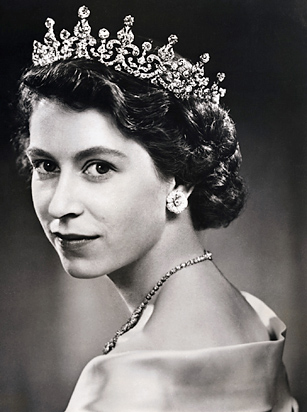
We know that the first Queen Elizabeth oversaw a period in which culture flourished, because Edmund Spenser's poem "The Faerie Queene" is about her — "that greatest Glorious Queene of Faerie lond" — because her birth is mentioned in one of Shakespeare's plays (Henry VIII) and because she was painted by some of the greatest masters of the age. The second Queen Elizabeth has also inspired several classics, perhaps none more indelible than this from the Sex Pistols: "God save the Queen/ She ain't no human being/ There is no future/ in England's dreaming."
If the cultural artifacts inspired by the first Elizabeth seem higher-toned, the second Elizabeth wins hands down on quantity. Her current Majesty is very likely the most portrayed woman on the planet. Billions of stamps, millions of coins and notes and hundreds of thousands of postcards bear her likeness. Her face, especially in profile, is recognized in every English-speaking land and is ubiquitous in several. Hers is not the exotic, come-hither face of a Marilyn or an Angelina. It's the face of distant historic authority, a literal figurehead, having no real power but oodles of symbolic supremacy.
Does ubiquity equal influence? The Queen does not inspire purchases the way Kate Moss or Kate Middleton might. She cannot give the sales of a certain brand of lipstick a fillip by casually dropping its name in conversation. But her complete lack of sex appeal or commercial appeal is actually the Queen's strength, buttressing her rarer and more potent qualities: consistency and longevity. Whatever flavor of the month Kate Middleton may be, it's never going to be as durable as the Queen's regal vanilla.
Officially, Elizabeth II has sat for roughly 200 portraits, by artists from Annie Leibovitz to Lucian Freud to hologram creator Chris Levine. She never gives her opinion on the results — at least not publicly — and seems to regard lending her time to artists as part of her cultural duty. The painters don't get to know their subject, because she can never be a subject. One artist — Justin Mortimer, whose portrayal stirred up controversy because it separated her head from her body — had two two-hour sittings with the Queen, mostly to take Polaroids and make sketches. "She sat very formally, like a Queen, in her chair and was chatting nonstop to her equerry," he recalled afterward. The second session was more relaxed but not intimate. "We even talked. She was funny." Another sitting, for Australian entertainer and painter Rolf Harris, was filmed, but the small talk was tiny.
Of course, the Queen's official portraits, even those by masters like Freud, are nowhere near as culturally relevant as her uncommissioned portrayals. She's vastly more influential as an icon than as a patron. As the apogee of all that is British and institutional and proper, Her Majesty serves as a useful target. Unchanging and unknowable, she is a perfect canvas on which to project the obsessions of the moment. Andy Warhol's silkscreen prints of Elizabeth, part of his "Reigning Queen" series of the mid-'80s, treats her like any other celebrity, frozen in time and bright colors. Earlier, Jamie Reid had rendered her with a safety pin through her nose in the style of a '70s punk.